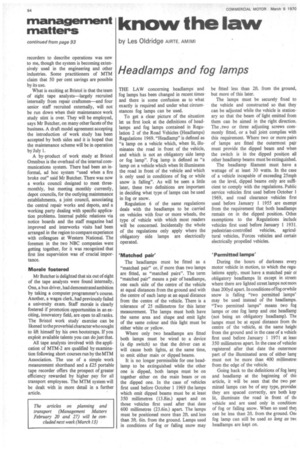know the law
Page 96

If you've noticed an error in this article please click here to report it so we can fix it.
by Les Oldridge AIRTE, AMIMI
Headlamps and fog lamps
THE LAW concerning headlamps and fog lamps has been changed in recent times and there is some confusion as to what exactly is required and under what circumstances fog lamps can be used.
To get a clear picture of the situation let us first look at the definitions of headlamps and fog lamps contained in Regulation 2 of the Road Vehicles (Headlamps) Regulations 1969. "Headlamp" is defined as "a lamp on a vehicle which, when lit, illuminates the road in front of the vehicle, and which is not an obligatory side lamp or fog lamp". Fog lamp is defined as "a lamp on a vehicle which when lit illuminates the road in front of the vehicle and which is only used in conditions of fog or while snow is falling". As will be seen a little later, these two definitions are important in deciding what type of lamps can be used in fog or snow.
Regulation 6 of the same regulations deals with the headlamps to be carried on vehicles with four or more wheels, the type of vehicle with which most readers will be concerned. Incidentally the whole of the regulations only apply where the obligatory side lamps are electrically operated.
'Matched pair' The headlamps must be fitted as a "matched pair" or, if more than two lamps are fitted, as "matched pairs". The term "matched pair" means a pair of headlamps, one each side of the centre of the vehicle at equal distances from the ground and with the centre of each lamp at an equal distance from the centre of the vehicle. There is a tolerance of 25 millimetres for this latter measurement. The lamps must both have the same area and shape and emit light of the same colour and this light must be either white or yellow.
Where only two headlamps are fitted both lamps must be wired to a device (a dip switch) so that the driver can at will cause both lights, at the same time, to emit either main or dipped beams.
It is no longer permissible for one headlamp to be extinguished while the other one is dipped, both lamps must be on together either on the main beam or on the dipped one. In the case of vehicles first used before October 1 1969 the lamps which emit dipped beams must be at least 350 millimetres (13.8in.) apart and on those vehicles first used after that date 600 millimetres (23.6in.) apart. The lamps must be positioned more than 2ft. and less than 3ft. 6in. from the ground. Lamps used in conditions of fog or falling snow may be fitted less than 2ft. from the ground, but more of this later.
The lamps must be securely fixed to the vehicle and constructed so that they can be adjusted while the vehicle is stationary so that the beam of light emitted from them can be aimed in the right direction. The .two or three adjusting screws commonly fitted, or a ball joint complies with this requirement. Where two or more pairs of lamps are fitted the outermost pair must provide the dipped beam and when the switch is in the dipped position all other headlamp beams must be extinguished.
The headlamp filament must have a wattage of at least 30 watts. In the case of a vehicle incapable of exceeding 25mph on the level, dipped beams only are sufficient to comply with the regulations. Public service vehicles first used before October 1 1969, and road clearance vehicles first used before January 1 1955 are exempt from the requirement that both headlamps remain on in the dipped position. Othel exemptions to the Regulations include vehicles first used before January 1 1931 pedestrian-controlled vehicles, agricultural vehicles, Forces vehicles and certain electrically propelled vehicles.
'Permitted lamps' During the hours of darkness every motor vehicle in motion, to which the regu. lations apply, must have a matched pair ol obligatory headlamps lit except in street! where there are lighted street lamps not more than 200yd apart. In conditions of fog orwhile snow is falling "two permitted lamps' may be used instead of the headlamps. "Two permitted lamps" means two fog lamps or one fog lamp and one headlamp (not being an obligatory headlamp). The lamps must be at equal distance from the centre of the vehicle, at the same height from the ground and in the case of a vehicle first used before January 1 1971 at lean 350 millimetres apart. In the case of vehicle! registered after that date the outermon part of the illuminated area of either lamp must not be more than 400 millimetret from the edge of the vehicle.
Going back to the definitions of fog lam/ and headlamp at the beginning of thit article, it will be seen that the two per mitted lamps can be of any type, provide( they are spaced correctly, are both kep lit, illuminate the road in front of tilt vehicle and are used only in conditioiu of fog or falling snow. When so used the3 can be less than 211. from the ground. Om fog lamp can still be used so long as twe headlamps are kept on.




























































































































































